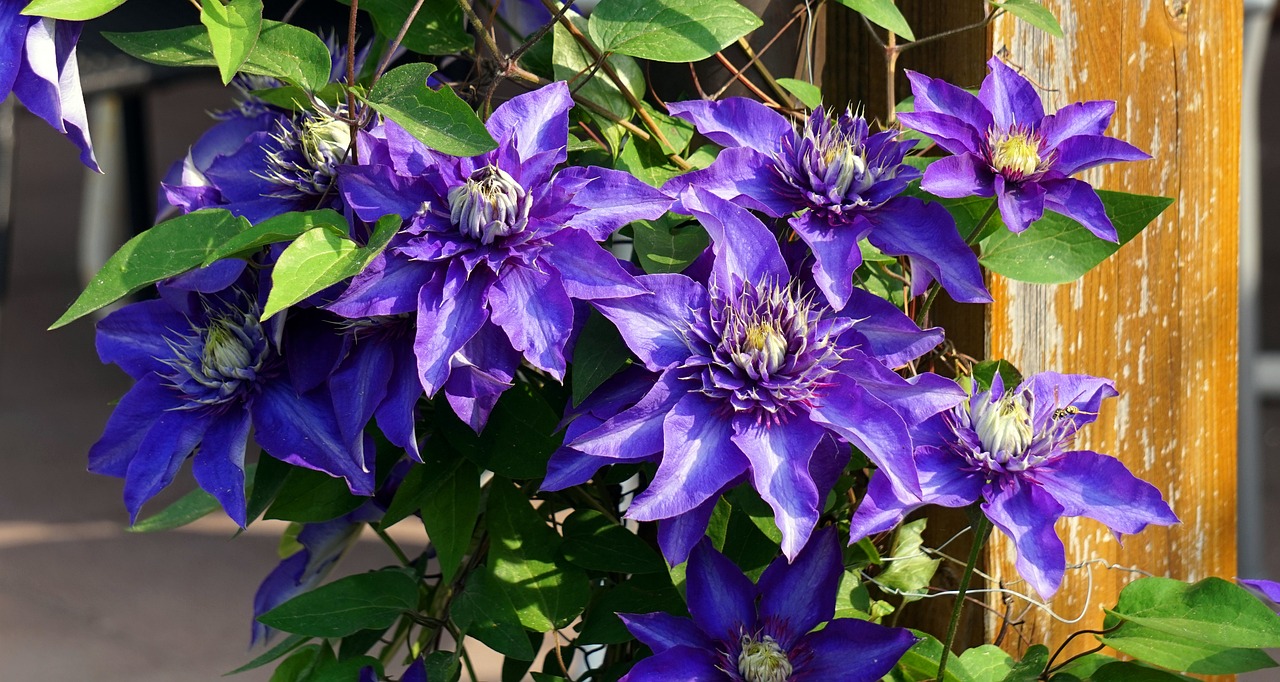Trumpet Vines (Campsis radicans)
Trumpet vines are known for their stunning, trumpet-shaped flowers that attract hummingbirds and butterflies. They can grow up to 30+ feet and are perfect for covering fences, trellises, and arbors.
Care Tips
- Planting: This plant does best with full sun to partial shade with well-draining soil.
- Watering: Water regularly during the first growing season to establish a deep, extensive root system. Once established, they are drought-tolerant.
- Pruning: Prune in late winter to control growth and encourage flowering.
- Support: Provide a sturdy structure for climbing.
Clematis (Clematis spp.)
Clematis is a beloved vining plant, celebrated for its variety of colors and forms. With flowers ranging from large and showy to small and bell-shaped, clematis can complement any garden style.
Visit Applewood Nursery & Landscape Supply, Your One-Stop Landscape Shop!
Care Tips
- Planting: Plant in a location where the roots are shaded, but the vine can climb into the sun.
- Watering: Keep the soil evenly moist, especially during dry periods.
- Pruning: Prune according to the group of your clematis (Group 1, 2, or 3) for optimal blooms.
- Support: Train on trellises, fences, or even other shrubs and trees.
Ivy (Hedera spp.)
Ivy is a hardy, evergreen vine that can cover walls, fences, and ground with its dense foliage. It’s particularly valued for its ability to thrive in shaded areas.
Care Tips
- Planting: Ivy prefers well-drained soil and can grow in full sun to full shade.
- Watering: Water regularly until established; it’s fairly drought-tolerant afterward.
- Pruning: Prune as needed to control growth and prevent it from becoming invasive.
- Support: Clings naturally to surfaces with its aerial roots.
Honeysuckle (Lonicera spp.)
Honeysuckle vines are fragrant and colorful, offering delightful blooms in shades of red, yellow, and white. They are excellent for attracting pollinators.
Care Tips
- Planting: Plant in full sun to part shade with well-drained soil.
- Watering: Water regularly, especially during dry spells.
- Pruning: Prune after flowering to maintain shape and encourage new growth.
- Support: Use trellises or fences to support their twining stems.
Vining Roses (Rosa spp.)
Vining roses, also known as climbing roses, are perfect for adding a touch of romance to your garden. Their fragrant blooms and ability to cover structures make them a favorite among gardeners.
William Baffin Rose, perhaps the hardiest and most vigorous climber available, has achieved almost legendary status with its seemingly endless procession of semi-double cherry red flowers throughout the summer, wonderful trailing over a fence or arbor.
Care Tips
- Planting: Choose a sunny spot with rich, well-drained soil.
- Watering: Water deeply and regularly, especially during dry periods.
- Pruning: Prune in late winter or early spring to remove dead wood and shape the plant.
- Support: Train on arbors, pergolas, or trellises.
Grape Vines (Vitis spp.)
Grape vines not only provide delicious fruit but also add a rustic charm to any garden. They can be grown on arbors, pergolas, or trellises.
Care Tips
- Planting: Plant in full sun with well-drained soil.
- Watering: Water regularly, especially during dry spells and the first growing season.
- Pruning: Prune in late winter to promote healthy growth and fruit production.
- Support: Train on strong structures like trellises or arbors.
Wisteria (Wisteria spp.)
Wisteria is a spectacular vining plant known for its cascading clusters of fragrant flowers in shades of purple, blue, and white. It can create stunning displays on arbors and pergolas.
Care Tips
- Planting: Plant in full sun with well-drained soil.
- Watering: Water regularly until established; then it becomes quite drought-tolerant.
- Pruning: Prune twice a year: once in late winter and again in summer to control growth and encourage blooms.
- Support: Requires sturdy support due to its vigorous growth.
Incorporating vining plants into your Minnesota garden can transform your outdoor space into a lush, green haven. Whether you choose the vibrant trumpet vine, the delicate clematis, or the fragrant honeysuckle, each vine brings its own unique charm and benefits. At Applewood Nursery & Landscape Supply, we have a wide selection of vining plants and all the supplies you need to help them thrive. Visit us today and let our experts help you choose the perfect vines for your garden.

